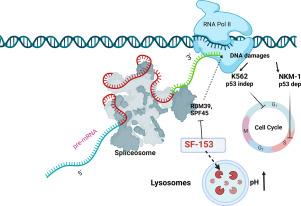UHM剪接因子抑制剂通过改变细胞周期进程和减少溶酶体酸化发挥抗白血病活性。
IF 3.7
2区 生物学
Q2 CELL BIOLOGY
引用次数: 0
摘要
成熟的mrna是由剪接体产生的,剪接体招募因子来帮助RNA剪接,其中内含子被移除,外显子连接。在这些剪接因子中,有一类蛋白含有一个同源的U2辅助因子(U2AF)同源基序(UHM),可与含有U2AF配体基序(ULM)的因子结合并招募它们调节3'剪接位点的选择。在癌症中经常发现UHM剪接因子的突变和过表达。虽然一些UHM抑制剂已被报道,但其在癌细胞中的活性尚未被研究。在这里,我们研究了我们最近发现的靶向RBM39和SPF45的UHM抑制剂SF-153,发现SF-153在三种白血病细胞系中具有抗肿瘤活性。在细胞周期和凋亡分析中,SF-153诱导p53介导的DNA损伤反应在NKM-1中延长S期,而在p53nullK562细胞中诱导p53非依赖性G1阻滞。SF-153处理的NKM-1的RNA-seq分析显示Myc靶基因和参与核苷酸和蛋白质合成的基因下调。Western blot分析证实Myc、EEF1A1和MCM7蛋白水平降低,表明NKM-1 DNA复制活性降低。来自RNA-seq数据的转录分析显示,6个基因改变了同种异构体模式,但在qRT-PCR中仅证实了一个DOCK2同种异构体的下调。RNA-seq分析还发现,SF-153破坏溶酶体酸化并抑制自噬,从而增强抗白血病活性。综上所述,我们的研究揭示了SF-153对白血病细胞抑制的多模态机制,为今后研究选择性UHM抑制剂奠定了基础。本文章由计算机程序翻译,如有差异,请以英文原文为准。

An inhibitor of UHM splicing factors exerts anti-leukemic activity by altering cell cycle progression and reducing lysosome acidification
Mature mRNAs are generated by spliceosomes that recruit factors to aid RNA splicing in which introns are removed and exons joined. Among the splicing factors, a family of proteins contain a homologous U2 Auxiliary Factor (U2AF) Homology Motif (UHM) to bind with factors containing U2AF ligand motifs (ULM) and recruit them to regulate 3′ splice site selection. Mutations and overexpression of UHM splicing factors are frequently found in cancers. Although a few UHM inhibitors have been reported, their activities in cancer cells were not investigated. Here, we studied our recently discovered UHM inhibitor, SF-153, that targeted RBM39 and SPF45, and found SF-153 exerted anti-tumor activities in three leukemia cell lines. In the cell cycle and apoptosis analysis, SF-153 induces p53 mediated DNA damage response to give protracted S phase in NKM-1 but p53-independent G1 arrest in p53null K562 cells. RNA-seq analysis of NKM-1 treated with SF-153 revealed downregulation of Myc target genes and genes involved in nucleotides and protein synthesis. Western blot analysis confirmed decreased proteins levels of Myc, EEF1A1, and MCM7 suggesting reduced DNA replication activity in NKM-1. Transcript analysis derived from the RNA-seq data indicated six genes changed isoform patterns but downregulation of only one DOCK2 isoform was confirmed in qRT-PCR. RNA-seq analysis additionally uncovered that SF-153 impaired lysosome acidification and inhibited autophagy to enhance the anti-leukemic activities. Taken together, our study characterized the multimodal mechanisms of inhibition by SF-153 in leukemia cells and laid the foundation for studying selective UHM inhibitors in future.
求助全文
通过发布文献求助,成功后即可免费获取论文全文。
去求助
来源期刊

Cellular signalling
生物-细胞生物学
CiteScore
8.40
自引率
0.00%
发文量
250
审稿时长
27 days
期刊介绍:
Cellular Signalling publishes original research describing fundamental and clinical findings on the mechanisms, actions and structural components of cellular signalling systems in vitro and in vivo.
Cellular Signalling aims at full length research papers defining signalling systems ranging from microorganisms to cells, tissues and higher organisms.
 求助内容:
求助内容: 应助结果提醒方式:
应助结果提醒方式:


